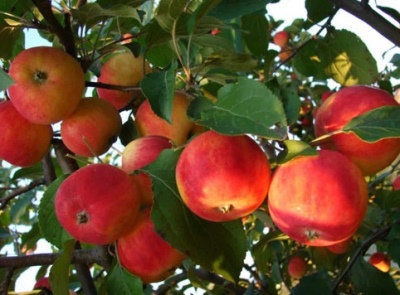
- Authors: Scientific Research Institute of Horticulture of Siberia named after M. A. Lisavenko. I. P. Kalinina, T. F. Kornienko, N. I. Dorokhina, G. V. Chupina
- Taste: sweet and sour
- Scent: thin
- Fruit weight, g: 50-60
- Fruit size: small and below medium size
- Yield: medium, up to 35 kg per tree
- Frequency of fruiting: annual
- The beginning of fruiting varieties: for 4-5 years
- Ripening terms: summer
- Keeping quality: up to 30 days
Apple tree Krasnaya Gorka is a vivid confirmation of the merits of the Siberian school of selection. This plant can become a faithful companion of the apple grower for many years. It can be used in household plots very widely.
Breeding history of the variety
The red hill was created at the Lisavenko Research Institute of Horticulture in Siberia. The team of breeders included I. P. Kalinina, T. F. Kornienko, N. I. Dorokhina, G. V. Chupina. The plant is a complex hydride. To obtain it, the varieties Gornoaltaisky, Belfleur-Kitayka and Melba were used. Grade testing began in 1992.
Description of the variety
The height of the trees reaches 1.5-2 m. The rounded crown is moderately dense. Small leaves are painted in a dark green tone. Characterized by a bend along the central vein. The finely serrated edge of the leaf is noted.
The branches are not too numerous and are of medium thickness. They are reddish brown in color. Ringworms and fruits are highly concentrated. Shoots are short, again, red-brown in color. The flowers are small, white or white-pink.
Features, pros and cons
Low culture is quite easy to care for. Growth in 1 season reaches 30 cm. The main branches are not too numerous, differ in average thickness. They are characterized by a red-brown bark. Important nuances:
small to medium-sized foliage with shiny surfaces;
short internodes;
the formation of apples on fruits, ringlets and annual growth.
Productivity is potentially high. However, it may not always manifest itself in specific conditions due to a number of unfavorable factors. The plant is susceptible to farming errors. The culture is predominantly suitable for private farming, and not for a large plantation. In favor of the apple tree Krasnaya Gorka speaks the abundance and high quality of the crop.
She is able to withstand difficult weather conditions. The tree configuration is very convenient. There are no big problems with growing. But the plant is sensitive to lack of moisture. During the dry season, apples are often crushed and crumbled.
Ripening and fruiting
Various sources mention that this is either a summer or early autumn variety. The first harvests are harvested in 4 or 5 years. In the future, it will be possible to feast on apples or sell them annually. Breaks in fruiting are uncommon. They always indicate only the wrong cultivation of the plant.
Growing regions
Krasnaya Gorka is zoned across the Altai Territory. There is a positive experience of its cultivation in other regions of Western Siberia. Given this, in places with more favorable climatic conditions, the chances are even higher.
Yield
The harvest from 1 tree can reach 35 kg. The stability of such a crop largely compensates for its relatively small size compared to more advanced varieties.
Fruits and their taste
The average weight of an apple is 50-60 g. Small or medium size is typical for it. Large white subcutaneous dots are easy to see. The peel on the fruit is thin and tender. Pink streaks in various places cross the creamy flesh.
This pulp itself has a fine-grained structure. A delicate, unobtrusive aroma is characteristic. The keeping quality of fruits reaches 1 month. The sugar concentration is 13.4%. The content of pectins is 3.46% in dry matter.

Growing features
Krasnaya Gorka will be able to winter in its main areas without any problems. Since the plant is not tall, there is no particular risk even from a cold, piercing wind. Caring for this crop requires pruning. It is done once every 6 months. In the spring, the crown is formed in order to exclude the pulling forces of the plant from the infertile stems.
The landing site should be chosen on the sunny side of the garden. Areas with high standing soil waters are unacceptable. The approximate date of the autumn landing is mid-September. This can be more accurately determined by the actual weather and forecast. In the spring you have to wait until the end of April or even the beginning of May.
The depth of the planting pits is normally 0.75-0.8 m. Their diameter is about 1 m. The upper fertile part of the soil is mixed with humus, thereby improving the quality of the soil. A stake must be used to support the seedling. The lack of a powerful root system allows you to limit the row spacing of 1.5-1.8 m.
Other important subtleties:
it is impossible to deepen the root collar;
protection from drafts is important;
it is worth choosing lighter places;
watering begins during budding and on average, adjusted for the weather, is carried out every 14 days;
in the spring, fertilizing with ammonium nitrate is needed;
phosphorus fertilizers are applied under the root from the beginning of budding and until the fruit is completely filled;
in the fall, it is recommended to use organic fertilizers and phosphorus-potassium compounds.






The apple tree is a popular fruit crop among gardeners. It can be found in many summer cottages. But at the same time, such trees are often affected by various diseases.It is very important to recognize the disease in time and carry out the necessary procedures for a speedy recovery. Otherwise, the fruits will be spoiled, and the tree itself may die altogether.












































































